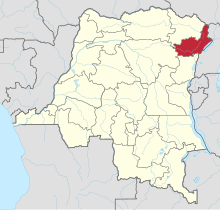Loading AI tools
Bantu ethnic group From Wikipedia, the free encyclopedia
The Hema people or Bahema (plural) are a Bantu ethnic group who are concentrated in parts of Ituri Province in the eastern Democratic Republic of the Congo.
 Map showing the location of Ituri Province in the Democratic Republic of the Congo | |
| Total population | |
|---|---|
| c.160,000[1] | |
| Regions with significant populations | |
| Ituri Province, Democratic Republic of the Congo | |
| Languages | |
| Northern Hema: Kilendu or Batha languages Southern Hema: Oruhema or Kinyoro languages | |
| Related ethnic groups | |
| Other Rutara people (Banyoro, Batooro, Bakiga, Banyankore, Bahororo, Basongora, Baruuli and Bahaya) |
The Hema are a Bantu ethnic group, related to the Banyoro, Batooro, Bakiga, Basongora, Bahororo, Baruuli and Banyankore. They were historically pastoralists and migrated into Ituri from modern-day Uganda in the early 19th century, making them one of the last groups to settle in the region.[2] The Hema are usually considered to fall into two distinct ethnic sub-groups:
There are generally thought to be 160,000 people who consider themselves Hema, mostly concentrated in Ituri Province in the Democratic Republic of the Congo.[1] Collectively, the Hema and Lendu people account for around 40 percent of the population in Ituri. They are a minority ethnic group, and one of 18 present in the same province.[2] Most Hema are Christians.[3]
It is generally considered that the Hema became more ethnically distinct under Belgian colonial rule when they were seen as more civilised than other populations in Ituri. Considered part of the mythical "Hamitic" people like the Tutsi, Hima and Songora in neighboring Uganda, Rwanda and Burundi, some Hema imagined joining with the aforementioned ethnic groups to form a Hima Kingdom. Hema political pre-eminence continued in Ituri after Congolese independence in 1960. Ethnic Hema continued to dominate local political appointments and business, at the expense of the Lendu who were largely excluded. Land reforms introduced by the regime of Mobutu Sese Seko in 1973 allowed Hema to partly dispossess land held by Lendu peasants.[4]
The ethnic tensions between Lendu and Hema was the primary cause of the Ituri conflict (1999-2003) which led to a collapse of state control in the region and genocidal violence. This was partly caused by the democratisation of Mobutu's regime which allowed the emergence of a Lendu elite before it collapsed entirely in the First Congo War (1996–97). However, the Rwandan Genocide was also important because the divide between Tutsi and Hutu was commonly projected over the Hema and Lendu respectively by both sides. During the Second Congo War, the Hema were widely believed to have collaborated with the Ugandan occupiers and the Ituri conflict was sparked by the installation of a Hema provincial governor by the Ugandan military in Ituri. Ethnic militias were formed and United Nations and European Union peacekeepers were deployed. In the ensuing conflict the Hema-backed Union of Congolese Patriots (Union des Patriotes congolais, UPC) fought the Lendu-backed Nationalist and Integrationist Front (Front des Nationalistes et Intégrationnistes, FNI) and various smaller groups. Sporadic fighting has continued since 1999. Uganda also became involved in the fighting which was aggravated by the presence of significant gold deposits in Ituri.
Seamless Wikipedia browsing. On steroids.
Every time you click a link to Wikipedia, Wiktionary or Wikiquote in your browser's search results, it will show the modern Wikiwand interface.
Wikiwand extension is a five stars, simple, with minimum permission required to keep your browsing private, safe and transparent.